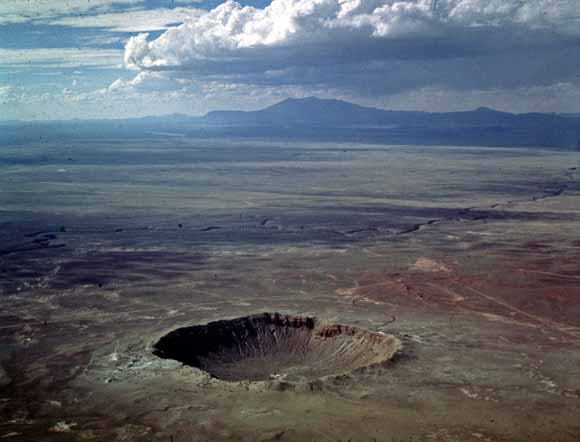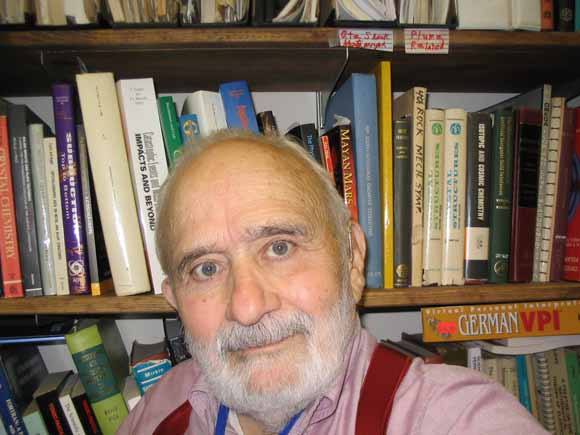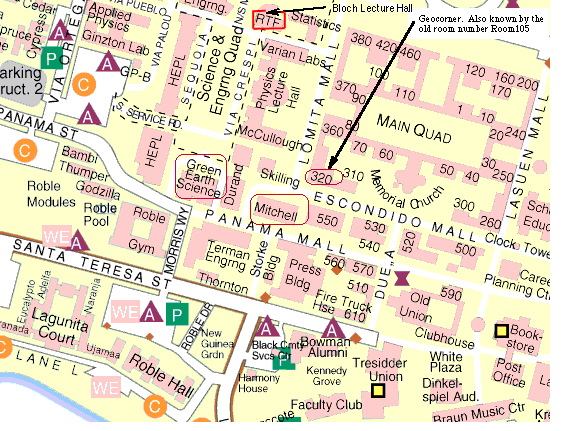
Location: Stanford University
see Map showing Mitchell and GeoCorner Room 320
This will be the 383rd meeting since 1954

The title of this talk is also the title of a paper by Nobel Laureate Harold Urey, published in the Astrophysical Journal 50 years ago. Most meteorites last solidified from melt about 4.5 billion years ago, making them the oldest objects available for study. The major motivation for the study of meteorites is to use the evidence in meteorites to test models of the early history of the solar system. For Urey, the fact that diamonds were found in some meteorites implied that these meteorites must have once been deep within a larger body, at least as big as the moon, at pressures within the stability field of diamond. His model was undone by SRI experiments showing that diamonds could be made by shock wave compression and by the one-to-one correlation between presence of diamond and metallurgical evidence for high shock pressures in individual meteorite fragments.
The study of meteorites is truly interdisciplinary: Geochemists analyze and date individual mineral grains, Metallurgists study diffusion profiles and shock wave metamorphic effects to interpret thermal histories of iron-nickel meteorites, Mineralogists and Shock Wave Physicists team to interpret the shock pressure-temperature histories of deformational features of stony meteorites.
This talk will give a broad overwiew of the current state of meteorite research, with emphasis on the speaker's interests in shock wave effects such as formation of high-pressure phases. Effects of large impacts, including dinosaur extinction, the "big whack" model for formation of the Moon, and delivery of Martian meteorites to the Earth, will be briefly touched upon.

Paul at his bookshelf
Paul S De Carli is a Senior Scientist Emeritus at SRI International and an Honorary Research Fellow in Earth Sciences at the University College London. He writes: "I was drafted to give a talk at the Sept. meeting of the American Society for Materials. After going to the work of preparing that talk, I'd be happy to give it again to the PGS. I'd modify the talk slightly, with more emphasis on high-pressure mineralogy and less emphasis on metallurgy. One of our PGS regulars, Bob Wallace, was at the ASM meeting and thought the talk would be appropriate for the PGS."
Paul was born in Stockton in 1930, started Stanford in 1948, and after a stint in the Army from '52-'54 and started at Stanford Research Institute (now SRI International) as a helper and explosives technician, and finished up at Stanford with a B.S. in metallurgy in 1957. As low man on the totem pole, Paul was assigned to help scientists who visited during the summer to conduct research or simply to learn about shock waves and consult in their specialties. Visitors included Fred Seitz, James Koehler, Morris Nicholson, Andrew Lawson, John Jamieson, and Joe Boyd. When John Jamieson suggested that it might be fun to see whether they could make coesite by shocking quartz, DeCarli designed an experiment to shock and recover quartz. When DeCarli's post-shock examination showed the recovered sample to be amorphous, he and Jamieson wrote the first paper on shock metamorphism of quartz. A single line in that paper notes that feldspar also became amorphous in a shock experiment.
The paper attracted the attention of Gene Shoemaker, whose office at the Menlo Park office of the USGS was about 100 m from Paul's office. Paul gave samples to Gene. Gene later gave a sample from the very first experiment to Sue Kieffer who went on to study shock metamorphism in Meteor Crater. Dan Milton, one of Gene's co-workers, subsequently suggested trying to duplicate the structure of Shergotty.
Another paper. Dan also taught DeCarli the techniques of purifying coesite and stishovite in shocked quartz. Another paper. Interestingly, the original sample of the 1959 paper contained stishovite. Concurrently, after the quartz paper, DeCarli was trying to understand shock amorphization. He consulted Maurice Huggins, a well-known crystallographer who was working at SRI. Huggins suggested that he look up metamict minerals. Of course! Tectosilicates are subject to radiation amorphization. Another material subject to radiation damage is graphite... the Windscale incident, a reactor excursion ascribed to radiation damage in graphite was in the news.
Shortly after the quartz experiment, an experiment with graphite was performed in 1959. The result: a material that abraded an agate mortar, scratched polished sapphire and gave a diffraction pattern that included weak and diffuse lines identical with diamond. Since theoretical studies had recently shown that it was not possible to shock-synthesize diamond, DeCarli's superiors were suspicious. Samples were sent to outside scientists who failed to detect diamond. Jamieson was the only scientist who agreed that diamond was present in the samples. Finally, after additional experiments and Jamieson's willingness to co-author, DeCarli was allowed to publish. Subsequently, Kathleen Lonsdale and Judith Milledge agreed that diamonds were present in DeCarli's samples. Erik Lundblad of ASEA also performed a shock experiment that confirmed DeCarli's results and he taught Paul the selective oxidation technique for purification of diamond.
During the early 60s, DeCarli and Ahrens were funded by NASA to work on shock effects in rocks and minerals. Ahrens took the contact with him when he joined CalTech, and DeCarli had to find other sources of support. Funding was becoming tighter and research contracts were much more narrowly constrained. Defense funding appeared the most reliable, so DeCarli moved into the development of shock wave instrumentation. His colleagues had previously developed techniques for using manganin piezoresistant stress gages for measurements up to about 35 GPa. DeCarli developed techniques for extending the range of manganin, eventually calibrating it over the range to 120 GPa.
Between about 1970 and 1995, most of DeCarli's efforts were devoted to development of shock wave instrumentation and to measurements on various defense related nuclear and high explosive experiments. Some of this work was performed in conjunction with joint Russian-US programs to monitor the yields of underground nuclear tests.
Since reaching retirement age in 1995, he has continued part-time work with SRI. His unpaid research efforts include a collaboration with Judith Milledge of University College London (UCL) to determine whether the Bangui magnetic anomaly corresponded to an asteroidal impact site and whether carbonado, a form of natural polycrystalline diamond, could be the result of shock synthesis. When one of the doctoral students at UCL, Emma Bowden, obtained a studentship to study shock wave metamorphism, Mr. DeCarli was asked to serve as her advisor, and he was appointed Honorary Research Fellow. Ms. Bowden successfully completed her research and her thesis. Mr. DeCarli has also been collaborating with Tom Sharp of ASU and with his students, teaching them enough shock wave physics to interpret shock effects in meteorites. One of DeCarli's personal goals is to teach the essentials of shock wave physics to as many persons as possible.
In order to make calculations of the cooling history of melt veins and pockets in meteorites, DeCarli learned to use a finite element heat transfer computer code. He then taught Tom Sharp's students to use the code. DeCarli is currently learning to use wave propagation computer codes. He is comparing the results of calculations with experimental results, and he is also collaborating with Adrian Jones and David Price of UCL in calculations of the effects of very large impacts on the Earth.
His post-retirement career has been productive, to date. The alert reader may note that there is no mention of DeCarli's advanced degrees. He doesn't have any. They were not needed when he started with SRI, nor did he have any money for further studies. In the 50s, US government support for higher education was virtually non-existent. By the time funding became available (the response to Sputnik), DeCarli was too involved with diamond synthesis and other problems to find time to return to school. He briefly considered obtaining a Ph.D as a retirement activity, but he has been too busy doing useful work, including tutoring MA students.

Paul at Italian Pride day
Reservations: The preferred way to make reservations is simply to email Janice Sellers at janicemsj@gmail.com by November 3, tell her you will attend, commit to pay, and bring your payment to the meeting. Janice always emails a confirmation; if you don't get one, assume email crashed yet again and email her a second time. A check made to "PGS" is preferred, payable at the meeting.
If you want to pay in advance:
Stanford faculty and students: Please make dinner reservations by November 3. Contact Dr. Elizabeth Miller via her mailbox (and leave check), Geological and Environmental Sciences Office, Geocorner - Bldg. 320 (Rm. 205). Make checks out to "PGS."
All others, including faculty and students from other Bay Area universities and colleges and USGS: Please make dinner reservations by November 3. Contact Janice Sellers, at 1066 28th Street, Oakland, CA 94608-4547, (510) 268-8254 . Send check made out to "PGS" to Janice.
Dinner is $30.00. Includes wine (5:30 to 6:15 PM.) and dinner (6:15-7:30 PM.).
For students from all universities and colleges, the dinner, including the social 3/4-hour, is $5.00 and is partially subsidized thanks to the School of Earth Sciences, Stanford University (Note, no-show reservations owe the full price).
Doris, whose wonderful crew prepares our meals, asked that we let you know that people who are late RSVP'ing and people who show up without a reservation will be welcome but that they will be eating on paper plates with plastic utensils (food supply permitting).
Dues for Academic Year 2006-2007 ($10.00) should be sent to Janice Sellers, 1066 28th Street, Oakland, CA 94608-4547. Janice's phone: (510) 268-8254.
Officers: Ray Wells, President; Dwight Harbaugh and Elizabeth Miller, Co-Vice Presidents; Mike Diggles, Secretary; Janice Sellers, Treasurer; Bob Coleman, Field-Trip Czar

Date created: October 21, 2006
Last modified: October 31, 2006
Created by: Mike Diggles, Webmaster-Secretary, PGS.